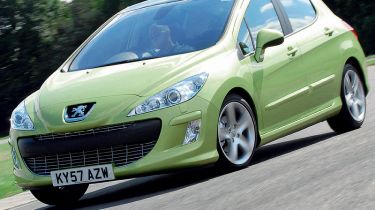Peugeot 308 (2008-2013) review
Peugeot hasn’t moved the game on in as many areas as we’d hoped.

Driving
The Peugeot has a very well judged blend of ride and handling, even on models with wide 17-inch wheels. The steering is taut, it’s capable through corners and feels one of the most mature cars in its class. It’s just not much fun, and the drivetrain needs to be slicker to be genuinely user-friendly; the gearbox is extremely poor, with a vague shift, and the clutch bite is high. We’d also advise choosing a diesel-engined 308; both 1.6-litre and 2.0-litre HDi units are smooth and torquey, whereas the non-turbo petrol units are gutless. Even the 1.6-litre 120 (developed with BMW and used in the MINI Cooper) fails to feel alive or even slightly energetic, though it does remain composed and quiet. Much more impressive is the 1.6-litre turbo 150, particularly as it’s also able to officially average 40mpg.
Marketplace
The 308 is an example of evolution, not revolution. It’s virtually identical to its 307 predecessor, and they also share the same floorpan and wheelbase – it’s not an all-new car. it’s a little larger than the 307, but most of the gains have been added to the nose. Peugeot offers the family hatch in three-door and five-door guise, with a line-up of Urban, S, SE, Sport and GT models; there are two different designs for the front and rear, depending on whether the trim is ‘classic’ or ‘sport’. Fierce competition comes from the Ford Focus, Volkswagen Golf, Vauxhall Astra and Honda Civic, while national rivals Citroen and Renault will also deal hard on the C4 and Megane.
Owning
Peugeot concentrated on improving interior quality for the 308 – and it’s been successful. The centre console, white dials and shapely steering wheel give a sense of quality, while the soft-touch plastics are smart. However, rear passenger room is little better than the 307, while the boot sill is very high and the 348-litre load volume disappointing. In order to fold the rear seats, the front chairs have to be slid forward; it’s clear practicality was not at the top of Peugeot’s agenda. However, with the glass roof that’s standard on SE and Sport models, the cabin is beautifully light and airy; the effect is best experienced from the rear. Sadly, the Peugeot’s running costs let it down. It’s expensive, retained values aren’t great and fuel economy of hard-driven petrol engines is poor. At least service intervals are lengthy – up to 20,000 miles between checks.
Engines, performance and drive
0MPG, CO2 and Running Costs
0Interior, design and technology
0Practicality, comfort and boot space
0Reliability and Safety
0More reviews
Car group tests
In-depth reviews
Long-term tests
Which Is Best
Most Economical
- Name1.6 Plug-in Hybrid 195 Allure 5dr e-DSC7
- Gearbox typeSemi-auto
- RRP£38,110







